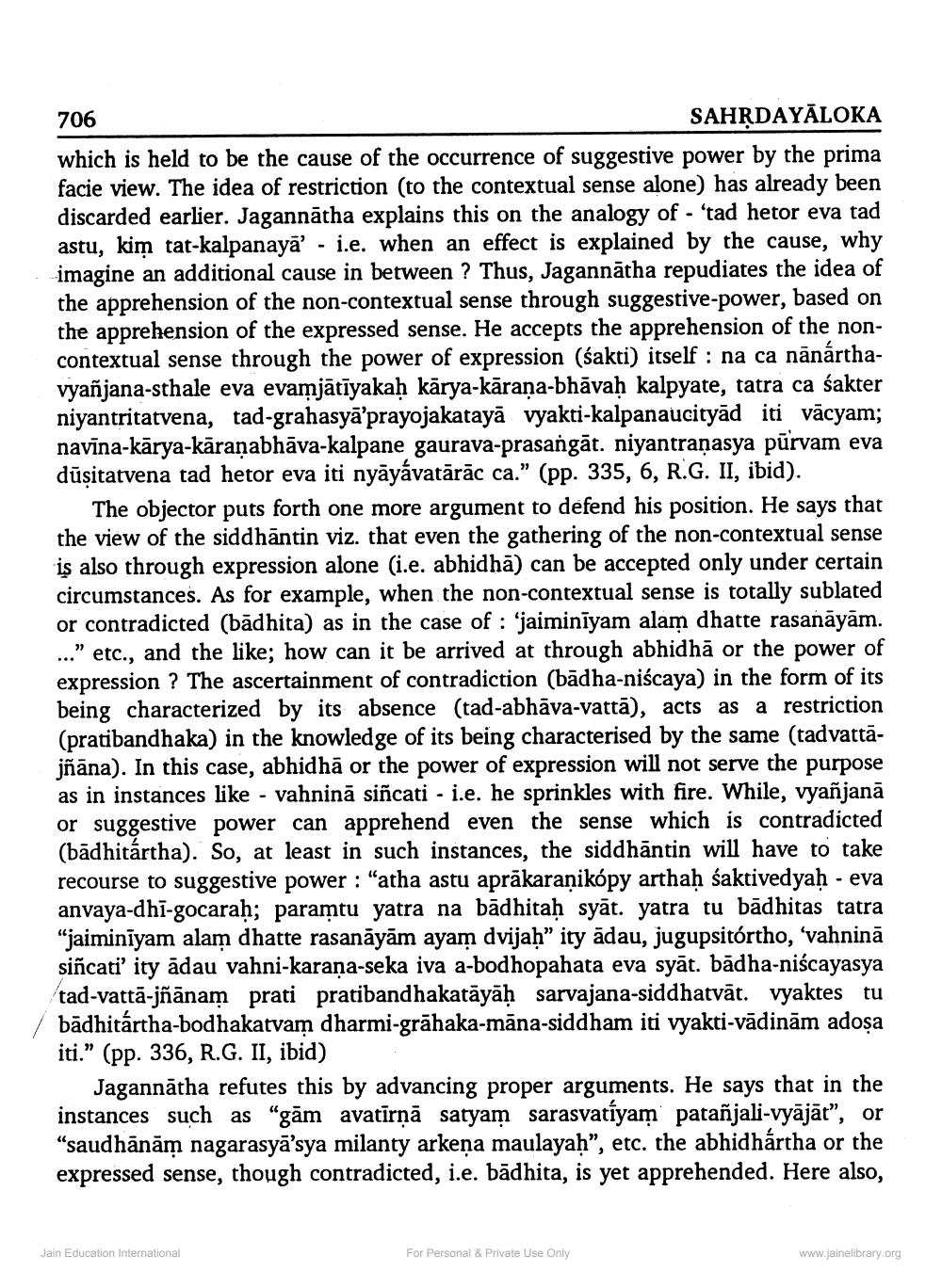________________
706
SAHĶDAYĀLOKA which is held to be the cause of the occurrence of suggestive power by the pri facie view. The idea of restriction (to the contextual sense alone) has already been discarded earlier. Jagannātha explains this on the analogy of - 'tad hetor eva tad astu, kim tat-kalpanayā’ - i.e. when an effect is explained by the cause, why imagine an additional cause in between ? Thus, Jagannātha repudiates the idea of the apprehension of the non-contextual sense through suggestive-power, based on the apprehension of the expressed sense. He accepts the apprehension of the noncontextual sense through the power of expression (sakti) itself : na ca nānárthavyañjana-sthale eva evamjātīyakaḥ kārya-kāraṇa-bhāvaḥ kalpyate, tatra ca śakter niyantritatvena, tad-grahasyā'prayojakatayā vyakti-kalpanaucityād iti vācyam; navīna-karya-kāraṇabhāva-kalpane gaurava-prasangāt. niyantraṇasya pūrvam eva dūsitatvena tad hetor eva iti nyāyávatārāc ca.” (pp. 335, 6, R.G. II, ibid).
The objector puts forth one more argument to defend his position. He says that the view of the siddhāntin viz. that even the gathering of the non-contextual sense is also through expression alone (i.e. abhidhā) can be accepted only under certain circumstances. As for example, when the non-contextual sense is totally sublated or contradicted (bādhita) as in the case of : 'jaiminīyam alam dhatte rasanāyām. ..." etc., and the like; how can it be arrived at through abhidhā or the power of expression ? The ascertainment of contradiction (bādha-niscaya) in the form of its being characterized by its absence (tad-abhāva-vattā), acts as a restriction (pratibandhaka) in the knowledge of its being characterised by the same (tadvattājñāna). In this case, abhidhā or the power of expression will not serve the purpose as in instances like - vahninā siñcati - i.e. he sprinkles with fire. While, vyañjanā or suggestive power can apprehend even the sense which is contradicted (bādhitártha). So, at least in such instances, the siddhāntin will have to take recourse to suggestive power : “atha astu aprākaranikópy arthaḥ śaktivedyaḥ - eva anvaya-dhi-gocaraḥ; paramtu yatra na bādhitaḥ syāt. yatra tu bādhitas tatra "jaiminīyam alam dhatte rasanāyām ayam dvijaḥ” ity ādau, jugupsitórtho, 'vahninā siñcati' ity adau vahni-karana-seka iva a-bodhopahata eva syāt. bādha-niścayasya tad-vattā-jñānam prati pratibandhakatāyāḥ sarvajana-siddhatvāt. vyaktes tu badhitártha-bodhakatvam dharmi-grāhaka-māna-siddham iti vyakti-vādinām adosa iti.” (pp. 336, R.G. II, ibid)
Jagannātha refutes this by advancing proper arguments. He says that in the instances such as “gām avatīrṇā satyam sarasvatiyam patañjali-vyājār”, or "saudhānām nagarasyā’sya milanty arkeņa maulayaḥ”, etc. the abhidhártha or the expressed sense, though contradicted, i.e. bādhita, is yet apprehended. Here also,
Jain Education International
For Personal & Private Use Only
www.jainelibrary.org




